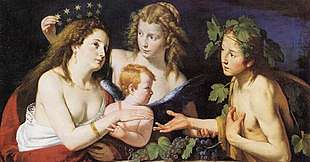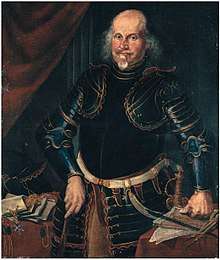Ermanno Stroiffi
Ermanno Stroiffi[1] (Padua, 20 October 1616 – Venice, 4 July 1693) was an Italian Baroque painter and priest. A pupil of prominent Venetian painter Bernardo Strozzi, he created altarpieces, portraits and genre scenes. Stroiffi became a priest in 1647 and in that role he helped to introduce the Oratory of Saint Philip Neri in Padua and Venice.[2]

Life
Stroiffi was born on 20 October 1616 in Padua as the son of the Flemish painter Giovanni (Jan or Johan, his original Flemish first and family name are not known) who was then working in Padua. His father died before 1644 as is demonstrated by Ermanno's signature on the will of Bernardo Strozzi in that year. His mother Laura died on 12 September 1652.[3]
Not much is known about the artist's training. It is known he became an assistant in the workshop of Bernardo Strozzi. Strozzi was the leading painter in Venice in the first half of the 17th century and also a Capuchin monk. Stroiffi was Strozzi's favorite assistant and worked on many of the large commissions which Strozzi received.[4] Stroiffi was also a beneficiary of Strozzi's will.[3]
Between 1645 and 1654 when he was still at the start of his career, Stroiffi travelled to various cities in central northern Italy. One of the cities was Mantua, the historic power base of the Gonzaga family, which was an important patron of the arts. He received commissions from the Ducal court. Other painters active at the court in Mantua at that time included Daniel van den Dyck, a Flemish artist who had moved to Mantua around 1657 and had become the court painter. In the 1650s Stroiffi participated in the cycle of the oratory of San Filippo Neri at the hospital of San Lazzaro dei Mendicanti in Venice.[5]

Stroiffi became a priest in 1647. He played an important role in the establishment of the Congregation of the Oratory in Padua and Venice.[6]
Work
Ermanno Stroiffi was a versatile and prolific artist who worked on canvas and as a fresco artist. He treated a wide range of subject matter including religious, mythological and allegorical themes as well as genre scenes and portraits. Some of his compositions include still life elements. Religious compositions make up the majority of his works. The number of works attributed to the artist is limited as a good part of his production is still submerged in the countless paintings attributed to Strozzi and his workshop.[7]
His style was close to that of his master Strozzi. He gradually developed away from Strozzi's example and created powerful compositions through the use of shade.[7]
The relationship between the works of Stroiffi and Strozzi can be illustrated through the early work Fruit vendor (Ducal palace, Mantua). The work was only recently attributed to Stroiffi after having been attributed to a painter in the circle of Strozzi. The work was created in Mantua during the years of Stroiffi's apprenticeship. The painting is derived from Strozzi's original (Stanley Moss collection, Riverdale on Hudson, N.Y.). Stroiffi has reworked his master's model in line with his personal artistic preferences. The veil of the fruit vendor appears softened and the male profile reflects a model by Stroiffi, which reappears in a series of works recently attributed to the artist. Another difference between Stroiffi's and Strozzi's versions is that the fabrics in Strozzi's original are swollen and crispy while they are drooping and flat in Stroiffi's work. Stroiffi has also added more fruit and vegetables, showing his interest in the still life genre.[5]
References
- Name variations: Ermano Stroiffi, Ermano Stoifi, Ermano Stroifi, Ermanno Stroifi, Don Armanno, Don Erman
- Venetian Seventeenth Century Painting: A Loan Exhibition from Collections in Britain and Ireland: 5 September to 30 November 1979: The National Gallery, 1979
- D. Cristante, Novita' ed aggiornamenti per Ermanno Stroiffi, in: Arte documento, Volume 11, Università di Udine. Cattedra di storia dell'arte moderna I., Centro per la promozione e lo sviluppo del corso di laurea in storia e tutela dei beni culturali, Electa, 1997, Page 108-117 (in Italian)
- Quatre nouveaux tableaux génois de Strozzi, Castiglione, Piola et Baciccio, Gallerie Canesso, p. 29
- Paolo Bertelli, Disiecta Membra, in: Giancarlo Malacarne, Renato Berzaghi, Stefano l'Occaso, Paolo Bertell, ‘Dai Gonzaga agli Asburgo: l'inventario del 1714 di Palazzo Ducale’, Edizioni Speroniane, pp. 159 (in Italian)
- Cecilia Ferrazzi, Autobiography of an Aspiring Saint Autobiography of an Aspiring Saint, The University of Chicago Press. 1996
- Ermanno Stroiffi (Padova, 1616 - Venezia, 1693), Madonna col Bambino e Sant'Antonio at Wannenes (in Italian)
External links
